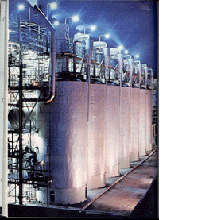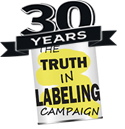How are monosodium glutamate and the other ingredients that contain MSG manufactured?
 Processed free glutamic acid (MSG) is created when protein is either partially or fully broken apart into its constituent amino acids, or glutamic acid is secreted from selected bacteria. A protein can be broken into its constituent amino acids in a number of ways (autolysis, hydrolysis, enzymolysis, and/or fermentation). When a protein is broken down, the amino acid chains in the protein are broken, and individual amino acids are freed. These processes are discussed in some detail in food encyclopedias -- wherein articles on glutamic acid and "monosodium glutamate" are generally written by persons who work for Ajinomoto, Co., Inc., the world's largest producer of the food ingredient "monosodium glutamate."
Processed free glutamic acid (MSG) is created when protein is either partially or fully broken apart into its constituent amino acids, or glutamic acid is secreted from selected bacteria. A protein can be broken into its constituent amino acids in a number of ways (autolysis, hydrolysis, enzymolysis, and/or fermentation). When a protein is broken down, the amino acid chains in the protein are broken, and individual amino acids are freed. These processes are discussed in some detail in food encyclopedias -- wherein articles on glutamic acid and "monosodium glutamate" are generally written by persons who work for Ajinomoto, Co., Inc., the world's largest producer of the food ingredient "monosodium glutamate." Today, the glutamic acid component of the food additive "monosodium glutamate" is generally made by bacterial or microbial fermentation wherein bacteria used are often, if not always, genetically engineered. In this method, bacteria are grown aerobically in a liquid nutrient medium. The bacteria have the ability to excrete glutamic acid they synthesize outside of their cell membrane into the liquid nutrient medium in which they are grown. The glutamic acid is then separated from the fermentation broth by filtration, concentration, acidification, and crystallization, and, through the addition of sodium, converted to its monosodium salt.
According to The Encyclopedia of Common Natural Ingredients:
"Monosodium glutamate can generally be produced by three methods: (1) hydrolysis of proteins such as gluten or proteins present in sugar beet wastes, (2) synthesis, and (3) microbial fermentation. In the hydrolysis method, the protein is hydrolyzed with a strong mineral acid to free amino acids, and the glutamic acid is then separated from the mixture, purified, and converted to its monosodium salt, [monosodium glutamate]. This used to be the major method of [monosodium glutamate] manufacture. Currently most of the world production of [monosodium glutamate] is by bacterial fermentation. In this method bacteria (especially strains of Micrococcus glutamicus) are grown aerobically in a liquid nutrient medium containing a carbon source (e.g., dextrose or citrate), a nitrogen source such as ammonium ions or urea, and mineral ions and growth factors. The bacteria selected for this process have the ability to excrete glutamic acid they synthesize outside of their cell membrane into the medium and accumulate there. The glutamic acid is separated from the fermentation broth by filtration, concentration, acidification, and crystallization, followed by conversion to its monosodium salt [monosodium glutamate]." (Leung, A. and Foster, S. Encyclopedia of Common Natural Ingredients Used in Food, Drugs , and Cosmetics. New York: Wiley, 1996. pp 373-375.)Creating processed free glutamic acid (MSG) by bacterial fermentation is not openly discussed by the glutamate industry, and it is not generally discussed in detail in food encyclopedias. It seems strange to us that when Ajinomoto discusses the way in which "monosodium glutamate" is manufactured, they talk about it being made from beets, corn, or some other crop, instead of describing their use of bacteria (which may be genetically engineered) and their process of bacterial fermentation.
It used to be that when any ingredient contained 78%-79% processed free glutamic acid (MSG), and the balance was made up of salt, moisture, and up to 1 per cent impurities, the FDA required that the product be called "monosodium glutamate", and required that the product be labeled as such. The FDA required that other MSG-containing ingredients be identified by names other than "monosodium glutamate." Never has the FDA required mention of the fact that an ingredient contains processed free glutamic acid (MSG). The last time we inquired, the FDA referred to the 6th edition of the Food Chemical Codex for their definition of "monosodium glutamate."
While the glutamic acid in "monosodium glutamate" is generally produced through bacterial fermentation, the glutamic acid in the other MSG-containing ingredients is made through use of chemicals (hydrolysis or autolysis), enzymes (enzymolysis), fermentation, or a complex cooking process wherein reaction flavors are produced from a combination of specific amino acids, reducing sugars, animal or vegetable fats or oils, and optional ingredients including hydrolyzed vegetable protein.
In acid hydrolysis, crude gluten or other proteinaceous starting materials are generally hydrolyzed by heating with hydrochloric acid. The chemical hydrolysis with hydrochloric acid is said to be efficient, but almost any organic substance in the raw material is hydrolyzed, resulting in desired reactions such as hydrolysis of proteins, carbohydrates, and/or fats (triglycerides), and the unwanted formation of mono and dichloro propanols, which are carcinogenic. (Food Chemical News, December 2, 1996. Pp.24-25.)
Enzymolysis is the splitting or cleavage of a substance into smaller parts by means of enzymatic action. By and large, acids, not enzymes, are used to hydrolyze proteins for use in food.
Reaction flavors are produced from a combination of specific amino acids, reducing sugars, and animal or vegetable fats or oils, and optional ingredients including hydrolyzed vegetable protein. Reaction flavors contain carcinogenic heterocyclic amines. (Lin, L.J. Regulatory status of Maillard reaction flavors. Division of Food and Color Additives, Center for Food Safety and Applied Nutrition, FDA. August 24, 1992; Food Chemical News. May 31, 1993, p 16.)
Processed free glutamic acid (MSG) carries with it material that is not found with the unprocessed glutamic acid found in intact/unadulterated/ unfermented protein. Unadulterated glutamic acid found in higher organisms is L-glutamic acid, only. In contrast, processed free glutamic acid (MSG) contains both L-glutamic acid and D-glutamic acid, and is also accompanied by pyroglutamic acid and other impurities. The impurities differ according to the starting materials and methods used to produce the glutamic acid (MSG). It is only acid hydrolyzed proteins that contain mono and dichloro propanols (which are carcinogenic), and it is only reaction flavors that contain heterocyclic amines (which are also carcinogenic).
By FDA definition, processed free glutamic acid (MSG) is "naturally occurring," because the basic ingredients are found in nature. "Naturally occurring" does not mean that a food additive is being used in its natural state. "Naturally occurring" only means that the food additive began with something found in nature. By FDA definition, the ingredient "monosodium glutamate" is natural. So is hydrochloric acid. So is arsenic. "Natural" doesn't mean "safe."
There are a number of straightforward bold faced lies used by the glutamate industry in defending its contention that exposure to free glutamic acid found in processed food does not cause adverse reactions including hives, asthma, seizures, and migraine headache; could not possibly cause brain damage, learning disorders, or endocrine disturbances; and could not possibly be relevant to diverse diseases of the central nervous system such as addiction, stroke, epilepsy, schizophrenia, anxiety, depression, and degenerative disorders such as ALS, Parkinson's disease, and Alzheimer's disease. Central to their argument is the lie that the processed free glutamic acid used in processed food is identical to the glutamic acid found in unprocessed, unadulterated food and in the human body.
"On the Subject of Manufactured vs. Natural Glutamic Acid" addresses this issue in considerable detail.

